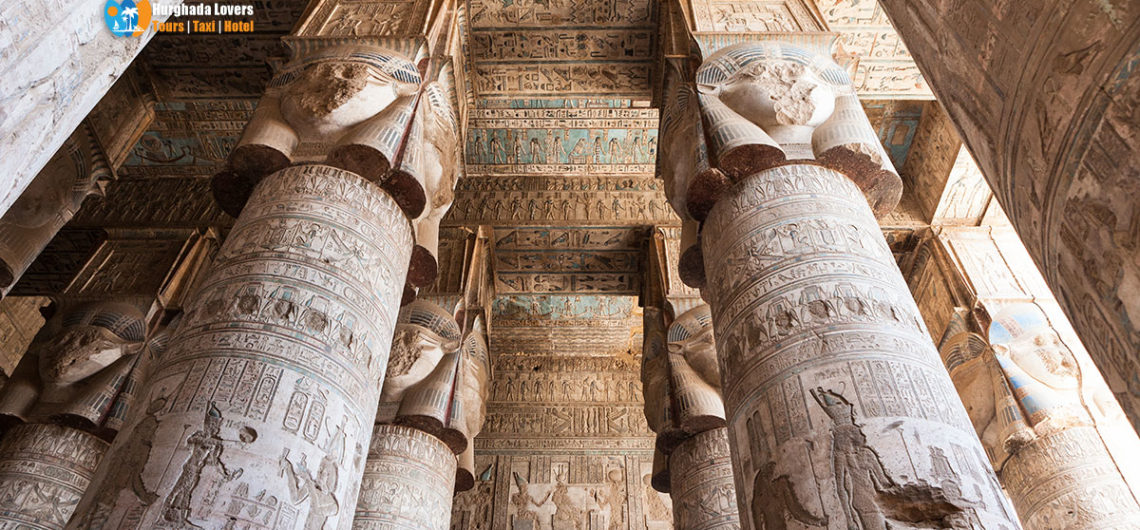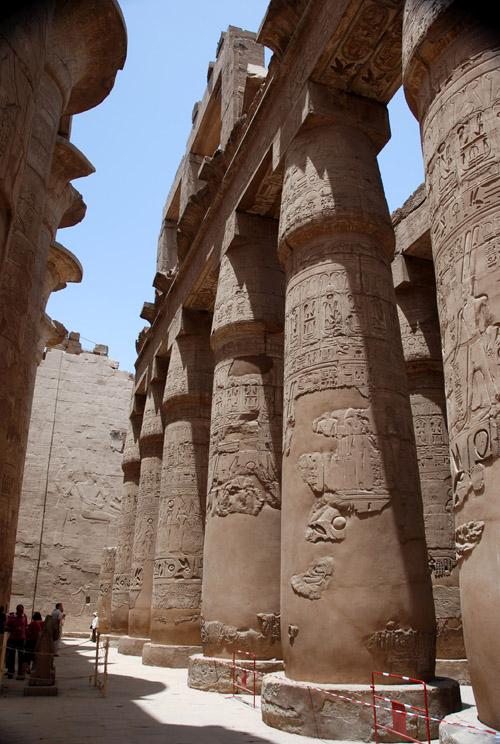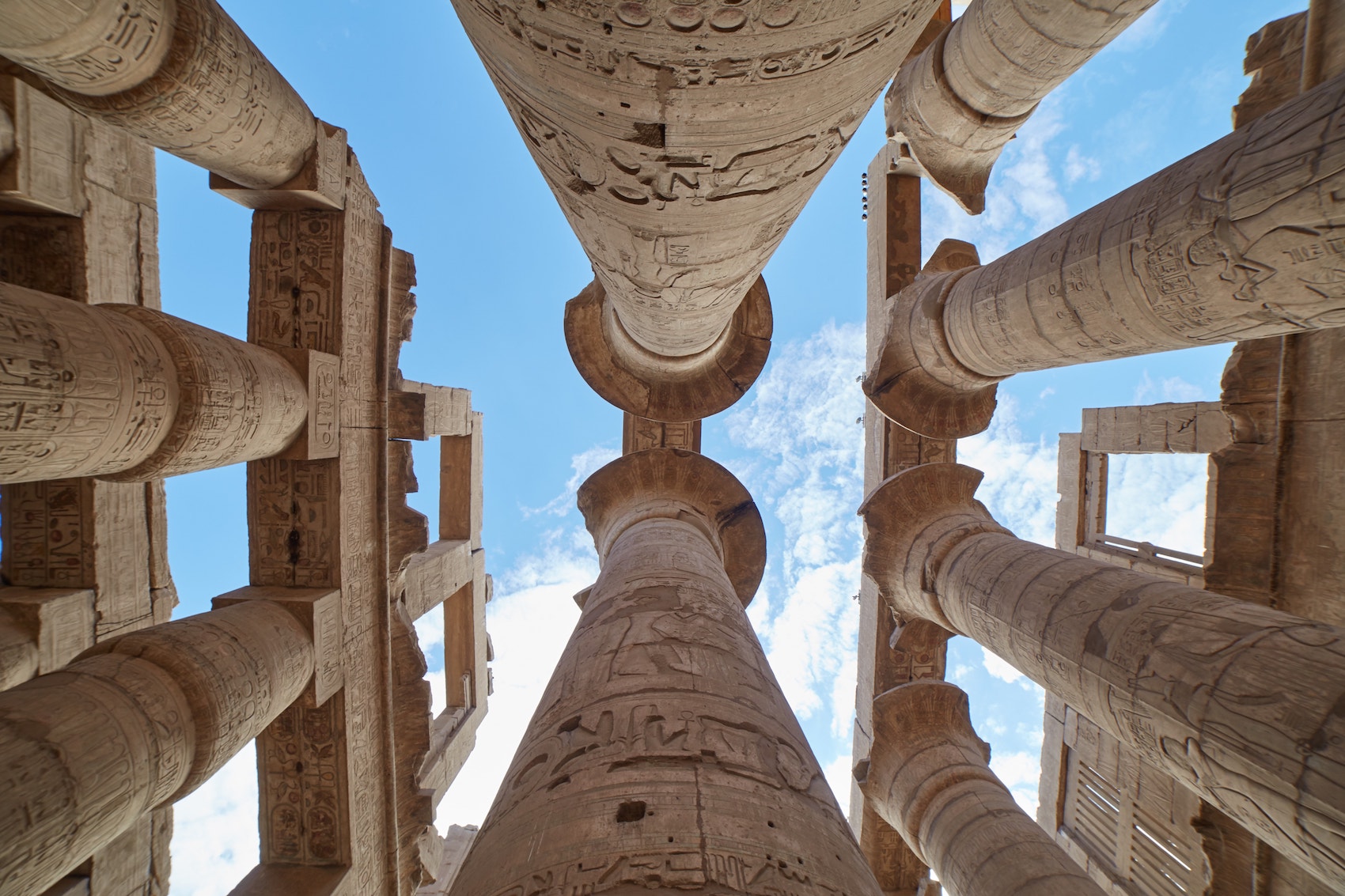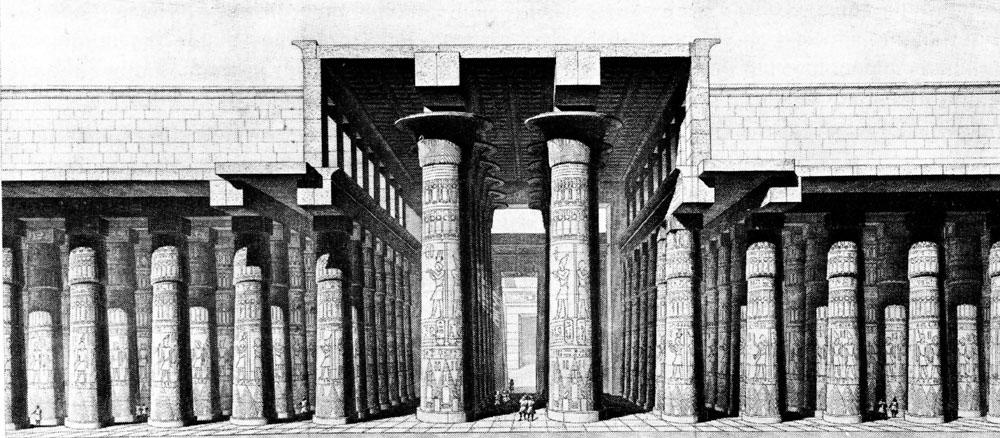The Great Hypostyle Hall: A Must-See in Karnak

Introduction to Karnak Temple Complex
The Karnak Temple Complex in Egypt is a must-visit destination for history buffs and those fascinated by ancient Egyptian culture. It is one of the largest temple complexes in the country and showcases the grandeur and architectural brilliance of ancient Egypt.
Overview of the Karnak Temple Complex
Spread over 200 acres; the Karnak Temple Complex is a vast open-air museum dedicated to the Theban Triad, consisting of the three main deities of ancient Thebes: Amun, Mut, and Khonsu. The complex was constructed over 2,000 years, from the Middle Kingdom to the Ptolemaic period. It contains numerous temples, sanctuaries, obelisks, and statues that leave visitors in awe of its rich history.
Significance of the Great Hypostyle Hall
One of the highlights of the Karnak Temple Complex is the iconic Great Hypostyle Hall. This colossal hall, measuring 54,000 square feet, consists of 134 massive columns arranged in a grid pattern. The columns rise to an impressive height of 80 feet and possess intricate hieroglyphic inscriptions and relief carvings.
The Great Hypostyle Hall served multiple purposes during ancient times. It was primarily used as a place for religious rituals and ceremonies. The high ceilings and towering columns were designed to create a sense of awe and reverence among worshippers.
Today's visiting the Great Hypostyle Hall offers a unique opportunity to step back in time. The grandeur and scale of the hall leave visitors in awe of the ancient Egyptians' architectural expertise and artistic prowess.
A visit to the Karnak Temple Complex is incomplete without exploring the majestic Great Hypostyle Hall. It is a testament to the skill and creativity of ancient Egyptian craftsmen and an opportunity to immerse oneself in the rich history and culture of this ancient civilization.

History and Architecture of the Great Hypostyle Hall
The Great Hypostyle Hall, located in Karnak, Egypt, is a remarkable architectural masterpiece that dates back to the reign of Pharaoh Seti I and Ramses II in the 13th century BCE. This immense hall encompasses an area of 5,000 square meters and consists of 134 monumental columns arranged in a grid-like pattern.
Construction and Purpose of the Great Hypostyle Hall
The construction of the Great Hypostyle Hall was a monumental feat. Its purpose was multifaceted, serving as a place of worship, a meeting space for religious ceremonies, and a symbolic representation of the Pharaoh's authority and power.
The hall was meticulously designed to create an awe-inspiring atmosphere. The larger central area features rows of towering columns, while the outer areas contain smaller columns. This design creates an illusion of depth and grandeur.
Architectural features and design elements
The architecture of the Great Hypostyle Hall is awe-inspiring. The hall is supported by rows of massive columns, with the tallest reaching a height of over 20 meters. Each column is intricately decorated with intricate carvings and hieroglyphics that depict religious scenes and stories from ancient Egyptian mythology.
The design elements utilized in the hall are astonishingly detailed. The columns are intricately carved to resemble papyrus plants, symbolizing regeneration and eternal life. The ceiling is decorated with astronomical motifs and geometric patterns.
The sheer scale and grandeur of the Great Hypostyle Hall make it a must-see attraction in Karnak. Visitors are transported back to ancient times as they walk among towering columns that have stood the test of time.
So, if you're planning a trip to Karnak, visit the awe-inspiring Great Hypostyle Hall. It offers a remarkable glimpse into ancient Egypt's architectural prowess and religious devotion.

Exploring the Columns of the Great Hypostyle Hall
The Great Hypostyle Hall in Karnak is a magnificent architectural marvel that must-see for anyone visiting Egypt. This ancient structure, built during the reign of Pharaoh Seti I and completed by his son Ramses II, is truly awe-inspiring. It is the largest room of any religious building in the world and features an astounding array of columns that leave visitors in awe.
Description of the massive columns and their symbolism
The Great Hypostyle Hall is characterized by its massive columns that create a forest-like atmosphere. The hall contains 134 columns, with 12 central columns soaring to a height of 24 meters. These towering columns are intricately decorated with carvings and hieroglyphics, depicting scenes from ancient Egyptian mythology and religious ceremonies. The symbolism found in these columns reflects the Egyptians' spiritual beliefs and their reverence for the gods.
Notable columns and their unique characteristics
Among the impressive columns found in the Great Hypostyle Hall, several notable ones stand out:
-
The Osiris Column: This column is dedicated to Osiris, the god of the afterlife. It features intricate carvings depicting Osiris' resurrection and his role as divine judge.
-
The Isis Column: Dedicated to the goddess Isis, this column symbolizes fertility and motherhood. It showcases scenes of Isis nursing the infant Horus, representing protection and nourishment.
-
The Hathor Column: Hathor, the goddess of love and music, is honoured with this column. It is adorned with depictions of Hathor playing musical instruments, emphasizing her role in joy and entertainment.
-
The Amun-Ra Column: This column pays homage to Amun-Ra, the king of the Egyptian gods. It showcases the god in various forms, representing his power and authority.
The Great Hypostyle Hall offers visitors a mesmerizing experience, immersing them in the grandeur of ancient Egyptian architecture and religious beliefs. The colossal columns and their symbolic representations glimpse the rich history and culture of this fascinating civilization.

The Decorative Relief Sculptures in the Great Hypostyle Hall
Within the vast and awe-inspiring complex of Karnak in Egypt lies a monumental structure known as the Great Hypostyle Hall. This architectural marvel was constructed during the reign of Pharaoh Seti I and his son, Ramses II, and it continues to captivate visitors with its intricate and mesmerizing relief sculptures.
Depictions of gods, pharaohs, and mythical creatures
As you enter the Great Hypostyle Hall, you are immediately immersed in a world of divine beings, powerful pharaohs, and fantastical creatures. The walls and columns are adorned with relief sculptures that depict various gods such as Amun, Osiris, and Horus. These deities are portrayed in larger-than-life sizes, conveying their importance and significance in ancient Egyptian mythology.
Not only do the relief sculptures showcase gods, but they also honour the pharaohs who commissioned their construction. Pharaoh Seti I and Ramses II are prominently featured, depicted in regal attire and engaged in religious rituals or military conquests. These intricate carvings testify to their divine right to rule and demonstrate their connection to the gods.
In addition to gods and pharaohs, the relief sculptures also depict mythical creatures believed to exist in ancient Egypt. These include sphinxes, griffins, and winged serpents, often seen as protective guardians or symbols of power.
Interpretation of the relief sculptures
The relief sculptures in the Great Hypostyle Hall provide invaluable insights into ancient Egyptian beliefs, rituals, and societal structure. They offer a visual narrative of religious ceremonies and mythological tales crucial to the ancient Egyptians' spiritual and cultural life.
Scholars and historians continue to study and interpret these relief sculptures to unravel the mysteries of ancient Egyptian civilization. By deciphering the symbolism and understanding the context in which they were created, we can gain a deeper appreciation for this remarkable culture's rich history and profound beliefs.
Visiting the Great Hypostyle Hall is truly an unforgettable experience. Its breathtaking beauty and incredible craftsmanship leave a lasting impression on all who have the opportunity to explore its grandeur. So, include this historical site in your itinerary when you journey to Karnak, Egypt.
Preservation and Restoration Efforts of the Great Hypostyle Hall
The Great Hypostyle Hall, located in the Karnak Temple Complex in Luxor, Egypt, is an architectural wonder that attracts tourists worldwide. Built during the reign of Pharaoh Seti I and completed by his son Ramesses II, this hall is a must-see for history and architecture enthusiasts alike.
Challenges faced in preserving the structure
Over the centuries, the Great Hypostyle Hall has faced numerous challenges threatening its preservation. These challenges include natural erosion, architectural decay, and even vandalism. Additionally, the rising groundwater level in the area poses a significant risk to the hall's foundation.
To combat these challenges, preservation experts have implemented various measures. These include regular maintenance and cleaning to remove accumulated dirt and debris and stabilizing the structure's foundation to prevent further damage.
Notable restoration projects and ongoing preservation efforts
Several notable restoration projects have taken place to ensure the longevity of the Great Hypostyle Hall. French architect Pierre Duval led one such project during the early 20th century. Duval's work focused on repairing damaged columns and restoring hall roof sections.
In more recent years, a team of archaeologists and conservationists have carried out ongoing preservation efforts. These efforts include documentation, research, and careful restoration techniques to preserve the hall's intricate reliefs and inscriptions.
The Egyptian government has also taken steps to protect this cultural heritage site. Strict regulations are in place to regulate visitor access and prevent further deterioration caused by excessive foot traffic.
Thanks to these preservation and restoration efforts, visitors can still marvel at the towering columns and admire the exquisite details that have survived.
The Great Hypostyle Hall is a testament to ancient Egyptian architecture. Its preservation and restoration efforts ensure that future generations can continue to experience its grandeur and appreciate its historical significance.

Visitor Experience and Tips for Exploring the Great Hypostyle Hall
The Great Hypostyle Hall in Karnak is an architectural marvel that should not be missed when visiting Egypt. The hall within the Karnak Temple Complex is a vast room supported by 134 massive columns with intricate carvings depicting religious scenes and symbols. Here are some tips for making the most of your visit:
Guided tours and audio guides
To truly appreciate the historical significance and architectural grandeur of the Great Hypostyle Hall, consider joining a guided tour or using an audio guide. Knowledgeable guides can provide valuable insights into the hall's history, symbolism, and cultural context. They can also highlight specific details and explain the significance of the carvings and hieroglyphics.
Audio guides are a great alternative if you prefer exploring at your own pace. They provide informative commentary as you navigate the hall, allowing you to delve deeper into its rich history and significance.
Best time to visit and important information for visitors
The best time to visit the Great Hypostyle Hall is early in the morning or late in the afternoon when there are fewer crowds. This will give you a better chance to fully immerse yourself in the awe-inspiring atmosphere of this ancient architectural wonder.
When planning your visit, it is important to note that photography inside the hall may be restricted or require additional permits. It is advisable to check with the local authorities or tour operators beforehand to ensure compliance with regulations.
Additionally, it is important to dress modestly and respectfully when visiting religious sites in Egypt. This means covering your shoulders, chest, and knees. Comfortable footwear is also recommended, as you may need to walk and stand for extended periods while exploring the hall.
By following these tips and taking the time to truly appreciate the beauty and historical significance of the Great Hypostyle Hall, your visit to Karnak will be even more memorable.

FAQ (Frequently Asked Questions)
Common questions and answers about the Great Hypostyle Hall
Q: What is the Great Hypostyle Hall in Karnak?
A: The Great Hypostyle Hall is a vast hall within the Karnak temple complex in Luxor, Egypt. It is one of ancient Egypt's most magnificent and well-preserved architectural wonders.
Q: How big is the Great Hypostyle Hall?
A: The hall covers an area of about 5,000 square meters (54,000 square feet) and consists of 134 massive columns arranged in 16 rows. The tallest columns reach a height of 24 meters (79 feet), creating an awe-inspiring sight.
Q: When was the Great Hypostyle Hall constructed?
A: The hall's construction began during the reign of Pharaoh Seti I (1290-1279 BCE) but was completed by his son, Ramses II (1279-1213 BCE). It took over 30 years to complete this impressive architectural achievement.
Q: What was the purpose of the Great Hypostyle Hall?
A: The hall was a sacred space for religious and ceremonial activities. It was primarily used for rituals dedicated to the Theban triad: Amun-Ra, Mut, and Khonsu. The hall's captivating columns and grand scale were designed to inspire a sense of awe and reverence in worshippers.
Q: Why is the Great Hypostyle Hall a must-see attraction?
A: Visiting the Great Hypostyle Hall provides a unique opportunity to witness ancient Egypt's grandeur and architectural mastery. The impressive columned hall's intricate carvings and hieroglyphs create a mesmerizing atmosphere that transports visitors back in time. It is an iconic symbol of ancient Egyptian culture and a testament to the skill and dedication of its builders.
Q: Are there any other notable features nearby?
A: Yes, the Karnak temple complex is vast and contains several other fascinating structures, including the Avenue of Sphinxes, the Precinct of Amun-Ra, and the Temple of Luxor. Exploring these additional sites will enrich your experience of ancient Egyptian history and culture.
